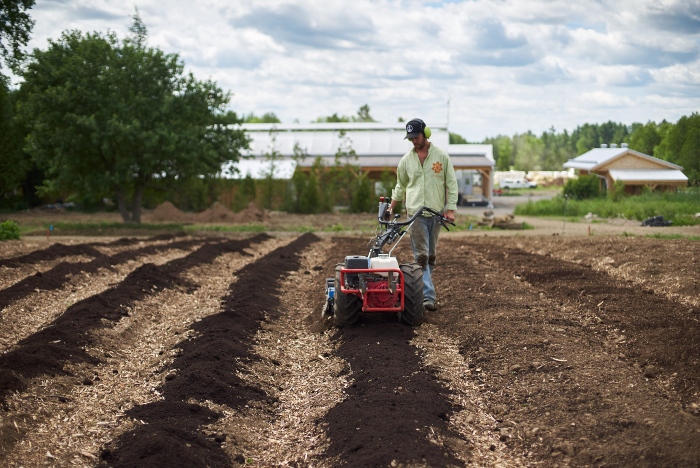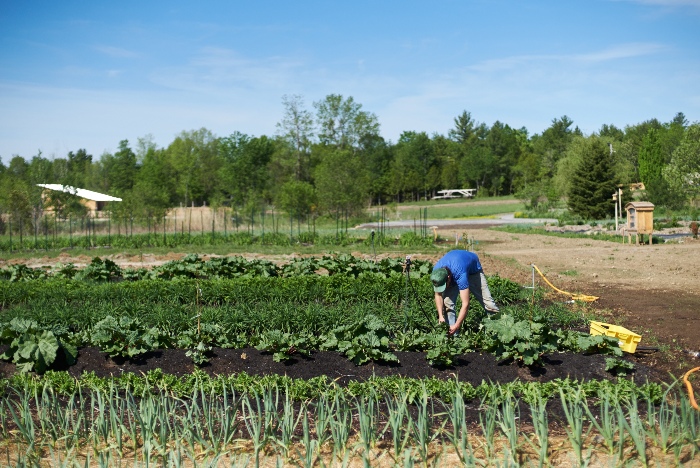Jean-Martin Fortier developed his method of biointensive production on his farms, which have become thriving businesses. After much trial and error, he designed techniques for market gardening and small-scale farming that are both effective and beneficial for the environment. Discover five good reasons to adopt the biointensive farming method.
The Biointensive Farming Method at a Glance
If you are new to the concept of biointensive agriculture, you may want to take a detour here to learn more about the main principles of Jean-Martin Fortier’s approach to biointensive farming.
In short, it’s a method in which growers maximize production on a minimal area of land, while preserving and improving soil quality. The method requires growing a wide variety of crops in a permanent bed system using tight spacing between plants on the row and between rows. This method also allows growers to do multiple crop successions on the same bed in one season and relies mostly on the use of inexpensive hand tools. The biointensive method is now preferred by thousands of growers around the world.
Here Are Five Good Reasons to Adopt the Biointensive Farming Method:
1. It democratizes access to land
In biointensive agriculture, one hectare (2.47 acres) of land is enough to become profitable. This economically advantageous method relies on a system of standardized, permanent raised beds with tightly spaced diversified crops. Cultivating smaller agricultural areas can also allow more aspiring farmers to venture into business, unlike mechanized, conventional agriculture, which requires larger sections of land to become profitable. In comparison, the non-mechanized nature of biointensive production requires a smaller initial investment, which also makes starting a farm more accessible for new and aspiring growers.

2. It nurtures the health of the soil
Biointensive farming diversifies the microbial life of soil and improves its quality. All amendments added to permanent beds, such as compost, green manures and other natural fertilizers, aim to nourish and enhance the soil fertility, which will help you grow top-quality crops. By carrying out different successive crop sowings on each bed, several plants can follow one another in a single season. The results are that they develop roots at varying depths, which despite successive plantings, prevents soil depletion. Once established, permanent raised beds do not need to be tilled or turned over, so microorganisms in the rhizosphere remain undisturbed. This kind of biodiversity is well-known to be beneficial for the soil; It allows for faster mineralization of organic matter into essential plant nutrients and reduces the threat of disease caused from pathogenic microorganisms. Optimizing soil health does not depend on the use of chemical fertilizers or pesticides, which makes biointensive agriculture a model that respects and supports the environment and the surrounding life in all of its forms.
3. It saves time
Planting crops close together in permanent raised beds cuts down on the time spent weeding. The close spacing of the plants creates a “canopy” of their foliage that reduces the pressure of weeds. Without as much light or space, weeds cannot grow as easily. The earth is also less bare, which is beneficial for reducing the threat of soil erosion. Due to the tight spacing, this allows for more efficiency when handling the day-to-day tasks around the farm because everything is easier to access!

4. It increases yields
By applying biointensive farming methods, you can maximize production in a permanent raised bed system. From optimizing each hectare or acre of land, you can gain higher revenues from the same surface area compared to conventional agricultural methods. Moreover, by planning sequences of successive sowings on the same bed, you can double or triple production for a designated area. This way of optimizing the amount of cultivated space is both economical and profitable.
5. It helps to support vibrant, thriving communities
We must replace industrialized, large-scale agriculture with a mass of small-scale organic farms. By multiplying small farms in regions all over the world, this can help to revitalize rural communities and encourage healthier lifestyles where top-quality food is ecologically grown and delivered directly to consumers shortly after harvest. This type of agriculture dramatically shortens the food chain and thus increases the strength and autonomy of regional food systems, while reducing harm to the environment. Small-scale agriculture is important for our collective future. It is imperative that we choose a model that offers a good quality of life to the dedicated and hard-working growers that commit their days to growing food for others.












